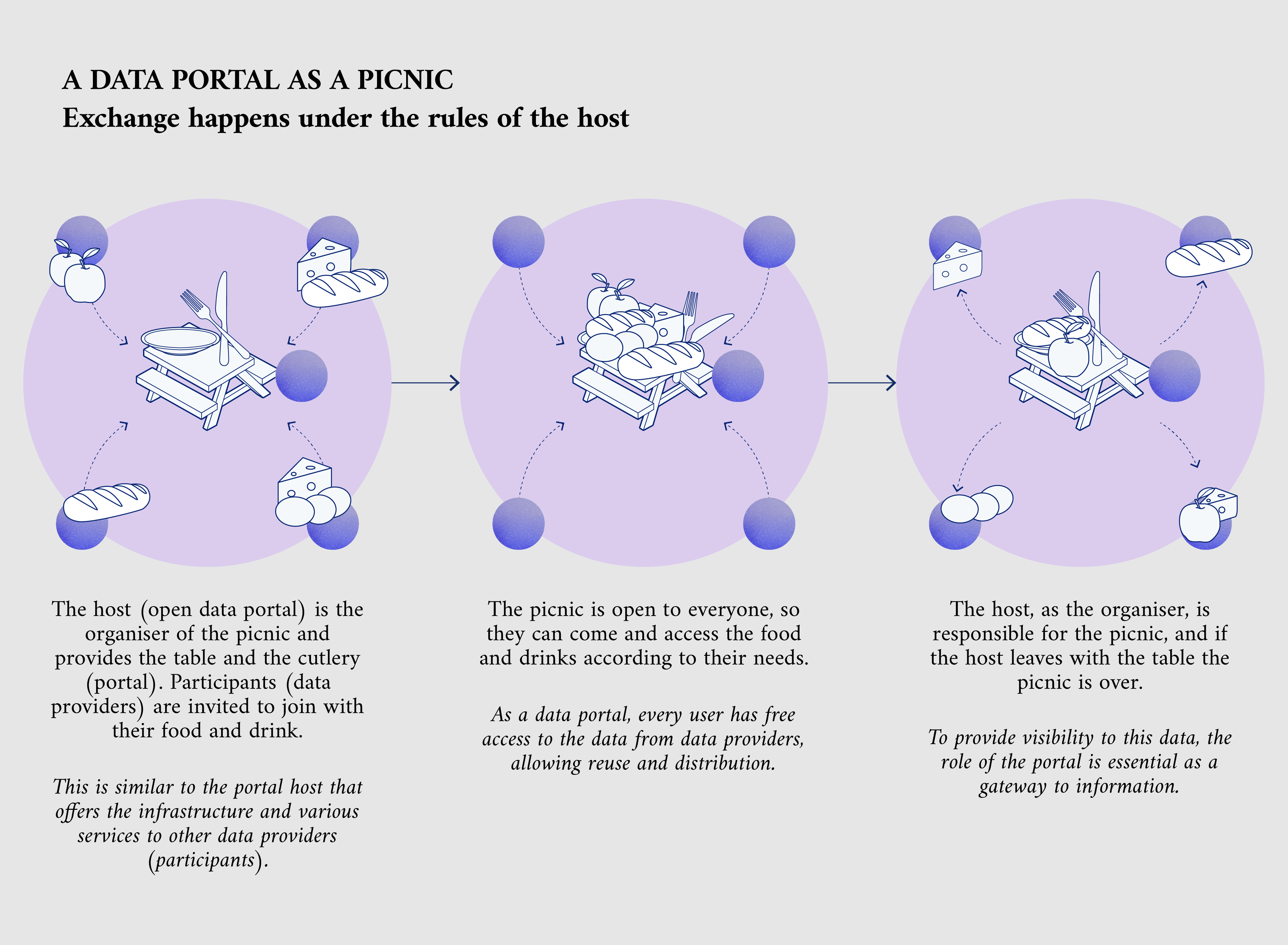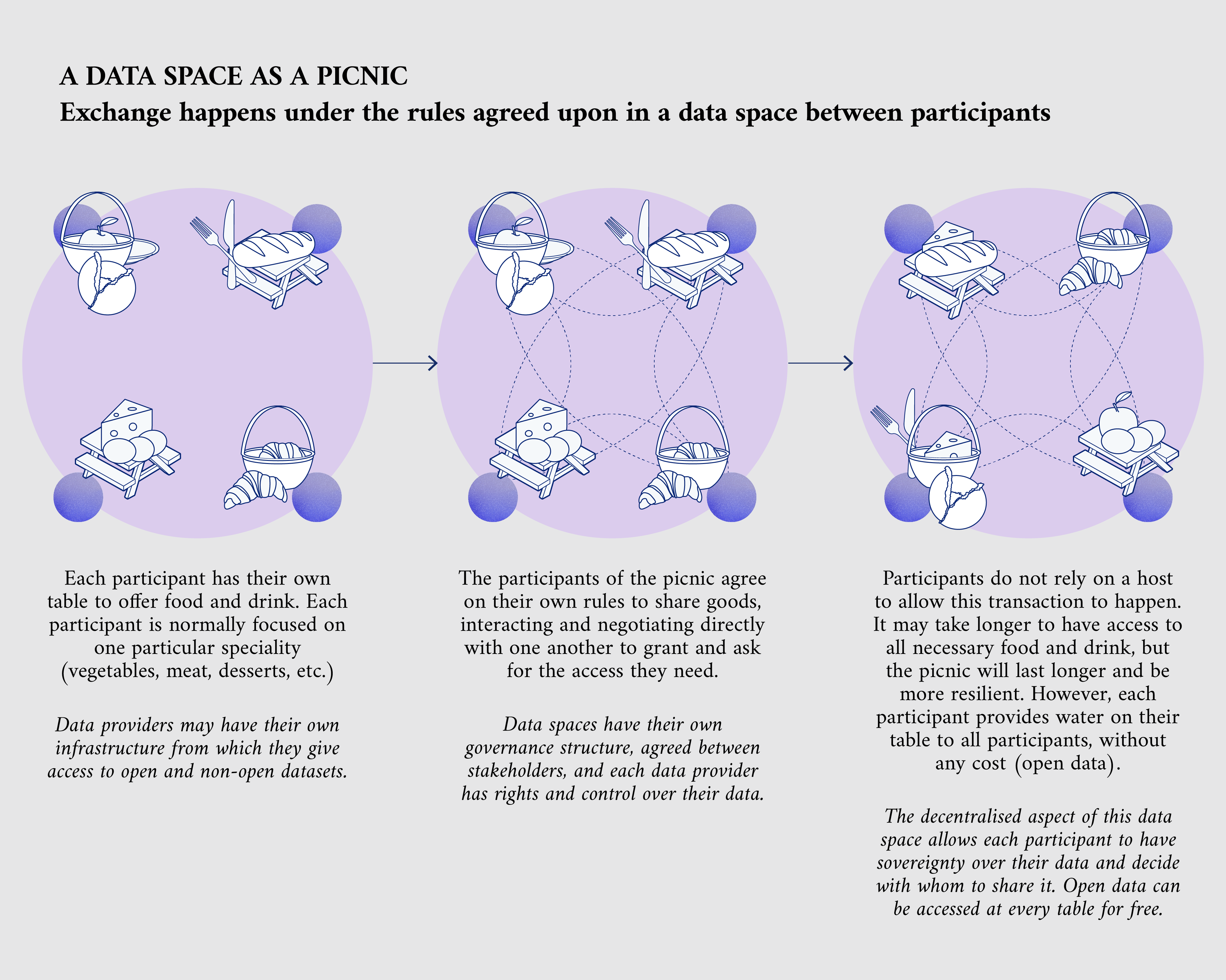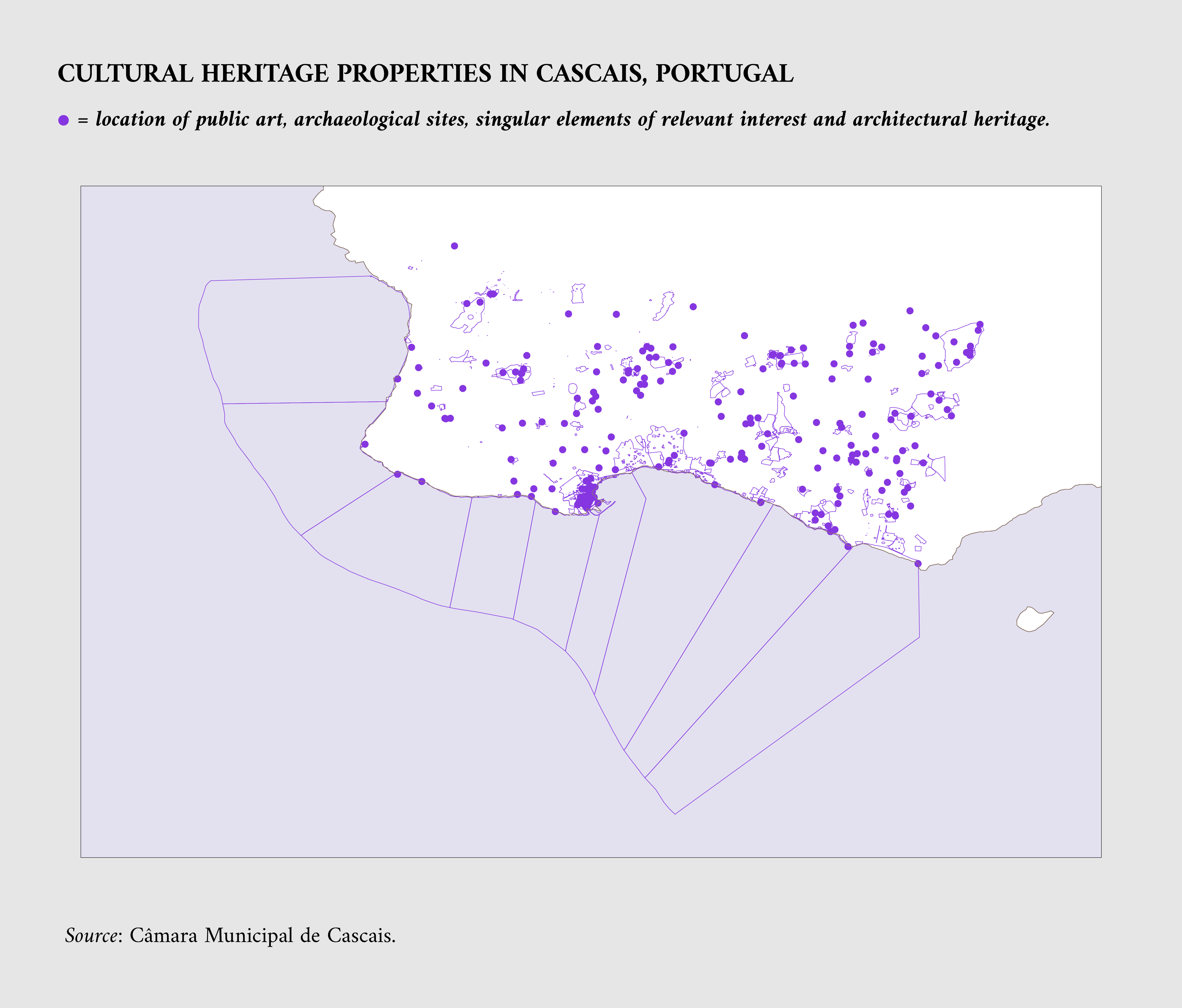When open data meets data spaces
A closer look at the concept of data spaces and the role of open data
The European data strategy sets out the vision of creating a single market for data where it can flow freely within the EU and across sectors. The creation of EU-wide, common, interoperable data spaces in strategic sectors is a pillar of the data strategy and will help overcome existing technical and legal barriers to data sharing and unleash the potential of data. These data spaces will bring together relevant data infrastructures and governance frameworks to facilitate data pooling and data sharing.
As a reader of data.europa.eu, you might already be familiar with open data and the value it offers. But what about the data in a data space? How do data spaces differ from open data portals, and what are the synergies between these two concepts? This data story explains the basic concepts of data spaces and how open data can multiply the impact of data spaces. We start with the foundations of data sharing and, after explaining what a data space is, end with examples of European data space initiatives.
Introducing the legislative landscape of open data and data sharing
Let’s start with open data. Why do public sector bodies in the EU share their data? EU’s open data directive encourages EU Member States to make as much public sector information available for reuse as possible, because of the additional value data-based innovation can create across all economic sectors (see the related impact assessment). It was also with this rationale that high-value datasets were defined for their important benefits for society, the environment and the economy.
However, not all data can be made available under an open data licence and on an open data portal. For this reason, the Data Governance Act includes mechanisms to facilitate the reuse of certain public sector data that cannot be made available as open data. The Data Act similarly seeks to make more data available for reuse, such as from citizen-generated data connected devices.
Whereas exchanging open data is relatively straightforward since the licensing terms allow reuse for any purpose, exchanging data with more restrictive conditions is a more complex transaction. This creates the need for more sophisticated functionalities to enable data sharing – enter data spaces.
What is a data space?
According to the Commission Staff Working Document on common European data spaces, a data space ‘brings together relevant data infrastructures and governance frameworks in order to facilitate data pooling and sharing’. The European Commission is funding the Data Spaces Support Centre to enable data spaces to develop coherently in the EU, for instance by establishing common requirements and best practices. For a complementary definition of a data space, the Data Spaces Support Centre’s glossary describes a data space as ‘An infrastructure that enables data transactions between different data ecosystem parties based on the governance framework of that data space’.
From a technical point of view, data spaces are a concept of data management: they put technology systems and rules in place to integrate and exchange data. What emerges is a federated data ecosystem based on shared policies and rules. Data is distributed across storage points and integrated on the basis of what is needed. Tools are provided to discover, access, and analyse data that is distributed across industries, companies and entities.
Data spaces exist around the world. In Europe, the EU is funding specific data space initiatives which typically aim to address the needs of a particular sector (such as agriculture or health). These data spaces should follow specific design principles and be interoperable and interconnected as a single market for data. As such, they are called the common European data spaces.
What are the differences between data portals and data spaces?
It is important to emphasise that the concept of data spaces differs from that of traditional open data portals. An open data portal refers to public websites set up by public administration entities (at the local, regional, national and supranational level) that publish data catalogues to support the discovery of public sector information in a format as open as possible to facilitate access, reuse and distribution.
To help understand the difference between data portals and data spaces, we can use the analogy of sharing food at a picnic. Imagine a picnic between friends. One friend hosts the picnic as the organiser, bringing the table and the cutlery (this friend represents the data-sharing infrastructure in the form of a portal) (Figure 1). Some friends (data providers) contribute to this picnic by bringing food and drinks. The data providers put the food and drinks on the table that is available to the rest of the friends (data reusers), who can check what is available and drink, eat and use what they like. This is an open picnic; any friend can come by and participate in the picnic as a provider or a consumer. The host provides the table and the cutlery which are needed to consume the food and drink.
This type of picnic has upsides. Without the host, the friends may not have come together for a picnic. However, this model also has downsides. The friends are dependent on the host. If the host is late, provides a table of bad quality or needs to go home, the friends do not have other options for their picnic.
This case is likened to a centralised platform that enables data sharing among participants. A data portal can serve users’ needs when a data-sharing ecosystem is developing and requires central coordination or when more straightforward design principles meet users’ needs, such as with open data where the licensing terms are straightforward.

Figure 1: An analogy for data portals as a picnic
However, having a one-size-fits-all picnic that meets everyone’s needs in every situation is difficult. Therefore, not all data-sharing ecosystems work like a data portal, which we will explain by picturing data spaces as a different kind of picnic. In this picnic, there is no host (Figure 2). Each friend has their own table where they can offer food and drinks. Friends give or take whatever they need in direct interaction with the other friends who need, or offer something. Someone brings food and drinks, someone else brings cutlery and dishes, and someone else brings a table. Each friend is the holder of the rights of what they offer. It may take longer for all the necessary food, drinks, cutlery and tables to come together, but it is likely that the picnic will take place if there are enough friends and they are diverse in their choices. The picnic is also more resilient since multiple friends can offer the same kind of food or supplies and since it lasts as long as someone is still around.
This case is likened to an ideal data space with a decentralised structure, where each participant has sovereignty over their data and can decide with whom to share it. This structure allows for various levels of openness in the data – some data is restricted and can be used by only certain stakeholders. Data spaces support this additional functionality for use cases that need it. Note: a data space does not need to be decentralised; several design choices characterise a data space, of which decentralisation is one of the more advanced options.

Figure 2: An analogy for data spaces as a picnic
How does open data fit into data spaces?
Open data is, by definition, already available to anyone, including to the participants in the common European data spaces. Therefore, open data can be considered a classic example of the kind of data that plays a role in all data spaces. Reusers could combine open data and data from data spaces to make innovative reuse cases that would not be possible with open data or data from data spaces alone. To refer again to the picnic analogy, open data is similar to the water provided for free on every table, regardless of the other arrangements each table makes.
Moreover, data spaces may also a be source for new open data, whether derived from pre-existing open data or created by processing the data offered by data space participants, in ways that make it suitable for redistribution under an open licence.
Data spaces in practice: the European Health Data Space and the Cultural Heritage Data Space
The data.europa academy organised a webinar to showcase specific examples of sectorial data spaces. In this session, the European Health Data Space and the Cultural Heritage Data Space showed the state of play of these data spaces and the particularities of their data spaces. Below, we highlight these use cases, explaining their ambitions.
- The European Health Data Space
The European Health Data Space (EHDS) is an example of an ambitious initiative within the broader health data space, specifically focusing on the EU. The COVID-19 pandemic highlighted the importance of sharing data across sectors to prevent and tackle health crises and improve our health systems. The EHDS aims to create a unified, secure and interoperable ecosystem for healthcare data across EU Member States. This includes empowering individuals through increased digital access to and control of their electronic personal health data at national and EU level. As such, the EHDS is a key pillar of the European health union and was the first common European data space in a specific sector to emerge from the European strategy for data. Specifically, this data space initiative seeks to facilitate the exchange of health data, encompassing electronic health records, patient data, medical research and more, to improve healthcare coordination, research and innovation. By promoting data sharing while respecting data privacy through measures such as general data protection regulation compliance, the EHDS strives to enhance healthcare outcomes, disease surveillance and cross-border healthcare services within the EU. The EHDS represents a significant step towards harnessing the power of data-driven healthcare while safeguarding the privacy and rights of individuals in the EU.
Open data relating to healthcare is already available and could be used to complement research projects seeking to use data such as patient records from the EHDS. For example, Eurostat has an EU-wide database of health data.
- The Cultural Heritage Data Space
Another example of a data space initiative is the European Cultural Heritage Data Space called Europeana. Europeana is a pioneering initiative focused on preserving, sharing and promoting information on Europe’s rich cultural heritage. Europeana brings together millions of items from museums, libraries, archives and galleries across the continent. Its mission is to provide public access to Europe’s cultural treasures, including artworks, historical documents and artefacts, in a digital format. By digitising and aggregating this diverse cultural content, Europeana facilitates cross-border access to European heritage and fosters cultural exchange and education. It strives to play a pivotal role in preserving and celebrating Europe’s cultural diversity while adhering to copyright and data privacy regulations and empowering cultural institutions to share their collections with the world. Europeana is a tool to preserve and promote the shared cultural identity of the European continent.
A wealth of cultural heritage information is already captured in open data. For example, the location of cultural heritage properties provides a geospatial context for cultural heritage (Figure 4). Therefore, such open data could be connected to archival images shared by a museum in a data space for a richer interpretation of the data.

Figure 4: Cultural heritage properties in Cascais, Portugal
Source: data.europa.eu/https://www.cascais.pt/
Conclusion
Common European data spaces support the vision of the EU’s data strategy of a data-driven society with a single market for data. Data spaces are complex federated ecosystems for data sharing. They offer technical infrastructure and governance models to enable participants to pool, access, process, use and share data trustfully and transparently. Even though data sharing has been facilitated through data portals already for a long time, data spaces offer new design principles that enable new use cases. The participants interact according to a shared policy and set of rules. This facilitates more complex data transactions between participants, such as specifying limits on how and for what purposes protected data can be reused.
Open data complements the data in data spaces and may encourage the development of innovative use cases that combine open and non-open data. Data spaces also offer opportunities for creating new open data, which could be derived from pre-existing open data or created through the appropriate processing of data in data spaces. Budding data space initiatives such as the European Health Data Space and the Cultural Heritage Data Space inspire ideas of how open data could be combined with data from data spaces for novel and insightful reuse cases. For example, granular data from electronic health records can be shared securely with authorised reusers for combined analysis with open data about healthcare. Similarly, data from private cultural heritage collections can augment governmental open data about cultural heritage.
Are you curious about data spaces and want to learn more? Watch the data.europa.eu academy’s series on data spaces. Also, stay tuned for our upcoming data stories and webinars by subscribing to our newsletter and following data.europa.eu on social media.
